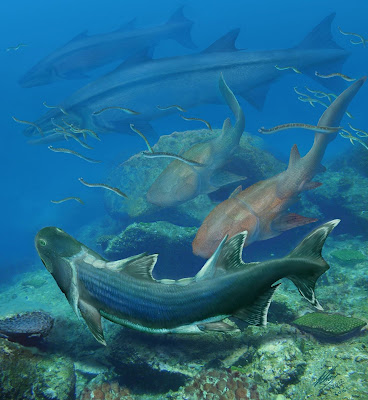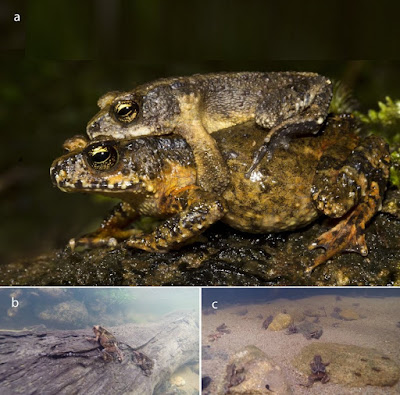![]() |
Figure 2. Photographs of some Ecuadorian species of Atractus in life: A. carrioni MZUTI 4194 (a), MZUTI 4195 (b), A. duboisi MZUTI 3640 (c), A. dunni MZUTI 4318 (d), A. dunni MZUTI 2189 (e), A. elaps AMARU SN (f), A. gigas MZUTI 3286 (g), A. iridescens MZUTI 3680 (h), A. iridescens QCAZ 8072 (i)
|
Abstract
We present a molecular phylogeny of snake genus Atractus, with an improved taxon sampling that includes 30 of the 140 species currently recognized. The phylogenetic tree supports the existence of at least three new species in the Pacific lowlands and adjacent Andean slopes of the Ecuadorian Andes, which we describe here. A unique combination of molecular, meristic and color pattern characters support the validity of the new species. With the newly acquired data, we propose and define the A. iridescens species group, as well as redefine the A. roulei species group. The species A. iridescens is reported for the first time in Ecuador, whereas A. bocourti and A. medusa are removed from the herpetofauna of this country. We provide the first photographic vouchers of live specimens for A. multicinctus, A. paucidens and A. touzeti, along with photographs of 19 other Ecuadorian Atractus species. The current status of A. occidentalis and A. paucidens is maintained based on the discovery of new material referable to these species. With these changes, the species number reported in Ecuador increases to 27, a number that is likely to increase as material not examined in this work becomes available and included in systematic studies.
Keywords: Pacific lowlands, biodiversity, Ecuador, groundsnakes, Atractus, phylogeny, new species
![]() |
Figure 2. Photographs of some Ecuadorian species of Atractus in life:
A. carrioni MZUTI 4194 (a), MZUTI 4195 (b), A. duboisi MZUTI 3640 (c), A. dunni MZUTI 4318 (d), A. dunni MZUTI 2189 (e), A. elaps AMARU SN (f), A. gigas MZUTI 3286 (g), A. iridescens MZUTI 3680 (h), A. iridescens QCAZ 8072 (i), A. iridescens MZUTI 4697 (j), A. iridescens MZUTI 3548 (k), A. major MZUTI 4973 (l), A. microrhynchus MZUTI 5109 (m), A. modestus (n), A. multicinctus MZUTI 5106 (o), A. occidentalis MZUTI 1385 (p), A. occidentalis MZUTI 3323 (q), A. paucidens MZUTI 5102 (r), A. resplendens MZUTI 3996 (s), A. roulei MZUTI 4503 (t), A. savagei MZUTI 4916 (u), A. snethlageae (v), A. touzeti ANF 2390 (w), and A. typhon MZUTI 5110.
|
![]() |
Figure 2. Photographs of some Ecuadorian species of Atractus in life: A. carrioni MZUTI 4194 (a), MZUTI 4195 (b), A. duboisi MZUTI 3640 (c), A. dunni MZUTI 4318 (d), A. dunni MZUTI 2189 (e), A. elaps AMARU SN (f), A. gigas MZUTI 3286 (g), A. iridescens MZUTI 3680 (h), A. iridescens QCAZ 8072 (i)
|
New taxa and systematic arrangements derived from the analyses
We seek here to only name or redelimit Atractus species groups that are supported in our molecular phylogeny and share features of their coloration pattern and lepidosis. The first such groups is the clade comprising A. cerberus sp. n., A. dunni, A. esepe sp. n., A. iridescens, A. microrhynchus and A. occidentalis. The other is the one comprising A. carrioni, A. lehmanni, A. pyroni sp. n. and A. roulei.
Atractus iridescens species group
Content. A. cerberus sp. n., A. dunni, A. esepe sp. n., A. iridescens, A. microrhynchus and A. occidentalis
Atractus roulei species group
Content. Atractus carrioni, A. lehmanni, A. pyroni sp. n. and A. roulei.
![]() |
Figure 2. Photographs of some Ecuadorian species of Atractus in life: A. iridescens MZUTI 4697 (j), A. iridescens MZUTI 3548 (k), A. major MZUTI 4973 (l), A. microrhynchus MZUTI 5109 (m), A. modestus (n), A. multicinctus MZUTI 5106 (o), A. occidentalis MZUTI 1385 (p), A. occidentalis MZUTI 3323 (q), A. paucidens MZUTI 5102 (r), A. resplendens MZUTI 3996 (s), A. roulei MZUTI 4503 (t), A. savagei MZUTI 4916 (u), A. snethlageae (v), A. touzeti ANF 2390 (w), and A. typhon MZUTI 5110.
|
![]() |
| Figure 5. Adult male holotype MZUTI 4330 (a) and adult male paratopotype (b) of Atractus cerberus MZUTI 5108. |
Atractus cerberus sp. n.
Proposed standard English name: Cerberus Groundsnake
Proposed standard Spanish name: Tierrera cancerbera
Natural history: The two known specimens of Atractus cerberus were found in an isolated patch of deciduous lowland forest surrounded by dry lowland shrubland. MZUTI 4330 was found active on leaf litter at 19h29, in 80% closed canopy secondary forest far from streams. The night was warm and there was drizzle the night before. MZUTI 5108 was found crossing a forest trail close to an open area at 10h00 during a sunny morning after a rainy night.
Distribution: Known only from the type locality, Pacoche, in the Ecuadorian province of Manabí at 280–324 m (Fig. 3). This locality is 3 km airline distance from the shoreline.
Etymology: The specific epithet “cerberus” is derived from the name of the Greek monster Kérberos. In Greek mythology, Kérberos is a monstrous multi-headed dog that guards the gates of the underworld, preventing the dead from leaving. Here, we use this word in allusion to the type locality, at the gates of the newly formed “Refinería del Pacífico”, a massive industrial oil-processing plant that can easily be likened to the underworld.
Atractus esepe sp. n.
Proposed standard English name: Indistinct Groundsnake
Proposed standard Spanish name: Tierrera indistinta
Natural history: The two known specimens of Atractus esepe were found actively foraging among soil and roots in secondary evergreen lowland forest at least 400 m from the nearest natural body of water. They were found by night at 20h00 after a warm, sunny day.
Distribution: Known only from the type locality, Caimito, in the Ecuadorian province of Esmeraldas at 102 m (Fig. 3). This locality is 1.3 km airline distance from the shoreline.
Etymology: The specific epithet esepe is derived from the Spanish pronunciation of “sp.”, which is the abbreviation for the Latin word species. Here, we use this word in allusion to how the majority of Ecuadorian researchers refer to Atractus specimens found in the field.
![]() |
| Figure 7. Adult female holotype of Atractus pyroni. MZUTI 5107. Scale = 1 cm. |
Atractus pyroni sp. n.
Proposed standard English name: Pyron’s Groundsnake
Proposed standard Spanish name: Tierrera de Pyron
Natural history: The only known specimen of Atractus pyroni was found dead on a dirt road surrounded by silvopastures and remnants of native montane cloudforest.
Distribution: Known only from the type locality, between Balzapamba and Bilován, in the Ecuadorian province of Bolívar at 2026 m (Fig. 7).
Etymology: Named after R. Alexander Pyron, one of the most prolific contemporary herpetologists, in recognition of his invaluable contribution to systematics and evolution of the world’s reptiles.
Alejandro Arteaga, Konrad Mebert, Jorge H. Valencia, Diego F. Cisneros-Heredia, Nicolás Peñafiel, Carolina Reyes-Puig, José L. Vieira-Fernandes and Juan M. Guayasamin. 2017. Molecular Phylogeny of
Atractus (Serpentes, Dipsadidae), with Emphasis on Ecuadorian Species and the Description of Three New Taxa.
ZooKeys. 661: 91-123. DOI:
10.3897/zookeys.661.11224










































































